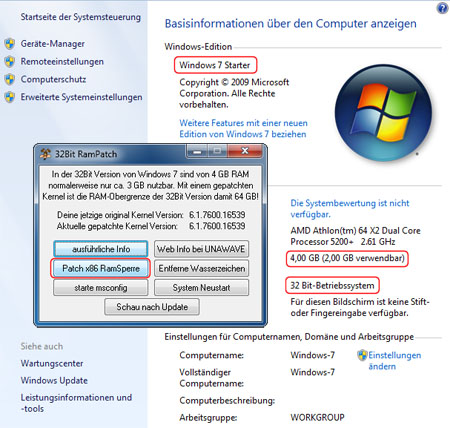Windows 7 and Windows Vista 32 bit can use the exact same amount of ram, a 32 bit operation system can only use a certain amount, it may show in your system as the ram is there but anything over 4GB is not being used and cannot being used, I say 4Gb because if you have 4gb in there the OS uses a certain amount and then the bios/OS used a decated amount for the Video Memory, but that is only if you have a IGP and not a deticated video card. Still using a 32-bit Windows machine? Here’s how to remove the 4GB limit that might be hampering your RAM usage. While 32-bit was once the standard, in recent years more and more Windows users have migrated to the 64-bit version of the OS. However, there are still some holdouts using 32-bit.
Most of us are now probably using a 64-bit Microsoft Operating System like Windows 7 x64 or Windows Vista x64, which allows the computer to address more than 3GB of RAM. Did you know, however, that any 32-bit applications you run are still limited to making use of only 2GB of RAM? This includes many games and probably the version of Microsoft Office you have installed, unless you specifically opted to install the 64-bit version.
You might wonder why this is a problem. Well, obviously if your system has more than 2GB of RAM, it’d be great to allow your applications or games to make use of it. Furthermore, some applications actually crash when they hit this limit, or start popping up boxes with out of memory errors. If you work on large excel files (500,000 rows+) then you’ll know what I’m talking about.

32-bit Windows 7 is hard-coded only address 4GB of TOTAL memory. If you have 4GB of RAM and 1GB of Video RAM, your video card gets 1GB which means now Windows only has 3GB of memory left to address (even though you have 4GB of free RAM). Windows 7 operative system and your PC’s hardware are limiting the maximal amount of memory that your PC can use. For 64-bit operating systems, that limit is theoretically non-existent, as 64-bit systems can read and use 192 GB of available RAM. For 32-bit operating systems, the set limit is 4GB of RAM. How to Increase the Maximum Usable Memory in Windows. Step 1: Type in Msconfig in the windows search box and press enter. Step 2: Select the Boot tab and click on Advanced options. Step 3: Select the Maximum Memory Checkbox and click on OK. That’s it, now you will need to reboot your PC and when it turns on. For more information, you can refer to this thread: 32 Bit Windows 7 and 4 gigabytes of RAm Please remember to click “Mark as Answer” on the post that helps you, and to click “Unmark as Answer” if a marked post does not actually answer your question.
The Solution
Thankfully, there’s a solution! A great coder by the name of Daniel Pistelli has written a little patching application that will modify your 32-bit programs, and allow them to address up to 4GB of RAM. It’s important to remember that this utility is only useful if you are running a 64-bit OS. If you don’t know what I’m talking about, then here’s an easy way to check:
1. Go to Control Panel, and click view by “small icons” in the top right hand corner
2. Click System
3. As per the image below, next to System Type, it should say 64-bit operating system. If it doesn’t then this utility is of no use to you.
Blue Badge Patch For Windows 7
The second thing to remember is that this utility can only be used on 32-bit applications. If you are unsure if an application you are running is 32-bit, run task manager by pressing CTRL-SHIFT-ESCAPE. Click the tab for processes. A list of currently running programs will load. Find your application in the list, and look to see if it has *32 next to it. The example image below illustrates what I mean.
Using the patch
Assuming that you’ve followed the previous two points and now wish to patch your 32-bit application, first backup the executable file of the program you wish to patch. If the patching process fails, or if you need to download an update for the program you are patching, you may need to revert to the original file. Remember, you only need to backup the executable file for the program (i.e. the file with a .exe extension), not the entire program folder itself. Once you’ve done this, download the patching utility from here. Run it, and it will ask you to select your program. Simply select the executable file you wish to patch and the utility will work its magic. Upon completion, it will ask you if you wish to patch another file. If you do, go ahead, if not, quit!
Conclusion
If all goes well, your application should now be able to make use of up to 4GB of RAM. Obviously this will be most useful for resource-intensive applications, and you’ll probably see the greatest benefits with games. Some productivity software will also benefit, assuming you aren’t utilising the 64-bit versions of these (e.g. Excel, Photoshop, 3D Studio Max, and so on.)
Patch For Windows 7 Activation
The Complete Windows 10 Customization Guide
Ram Patch For Windows 7 32-bit
In this ebook we’ll be exploring the multitude of options to fully customize Windows 10. By the end of this ebook you’ll know how to make Windows 10 your own and become an expert Windows 10 user.